A Review of Jurassic Paleoclimatic Changes and Tectonic Evolution in the Qaidam Block, Northern Qinghai-Tibetan Plateau
Abstract
1. Introduction
2. Geological Settings
3. Overview of the Kinematic History of the QB
3.1. Late Paleozoic
3.2. Mesozoic
4. Methodology
5. The Change in Paleoclimate After the T–J Mass Extension
5.1. Sedimentary Facies Evolution
5.2. Sporopollen Assemblage and Vegetation Succession
5.3. Chemical Weathering Indices
6. Tectonic-Climate Coupling Mechanisms
6.1. Chemical Weathering Indices Late Triassic–Early Jurassic: Formation of Basin-Mountain System Driven by Plate Collision and Establishment of Humid Climatic Vegetation System
6.2. Middle Jurassic: Vegetation Adaptation Under Tectonic Stress Transition and Climatic Fluctuations
6.3. Late Jurassic: Large-Scale Aridification Driven by Multi-Stage Tectonic Events
7. Summary
Author Contributions
Funding
Data Availability Statement
Acknowledgments
Conflicts of Interest
Abbreviations
| T–J | Triassic–Jurassic |
| CAMP | Central Atlantic Magmatic Province |
| QB | Qaidam Block |
| CIA | Chemical Index of Alteration |
References
- Steinthorsdottir, M.; Jeram, A.J.; McElwain, J.C. Extremely elevated CO2 concentrations at the Triassic/Jurassic boundary. Palaeogeogr. Palaeoclimatol. Palaeoecol. 2011, 308, 418–432. [Google Scholar] [CrossRef]
- Van Der Meer, D.G.; Zeebe, R.E.; van Hinsbergen, D.J.J.; Torsvik, T.H. Plate tectonic controls on atmospheric CO2 levels since the Triassic. Proc. Natl. Acad. Sci. USA 2014, 111, 4380–4385. [Google Scholar] [CrossRef]
- Zhao, G.C.; Wang, Y.J.; Huang, B.C.; Dong, Y.P.; Li, S.Z.; Zhang, G.W.; Yu, S. Geological reconstructions of the East Asian blocks: From the breakup of Rodinia to the assembly of Pangea. Earth-Sci. Rev. 2018, 186, 262–286. [Google Scholar] [CrossRef]
- Dong, Y.P.; Sun, S.S.; Santosh, M.; Zhao, J.; Sun, J.P.; He, D.F.; Shi, X.H.; Hui, B.; Cheng, C.; Zhang, G.W. Central China orogenic belt and amalgamation of East Asian continents. Gondwana Res. 2021, 100, 131–194. [Google Scholar] [CrossRef]
- Huynh, T.T.; Poulsen, C.J. Rising atmospheric CO2 as a possible trigger for the end-Triassic mass extinction. Palaeogeogr. Palaeoclimatol. Palaeoecol. 2005, 217, 223–242. [Google Scholar] [CrossRef]
- Capriolo, M.; Marzoli, A.; Aradi, L.E.; Callegaro, S.; Dal Corso, J.; Newton, R.J.; Mills, B.J.W.; Wignall, P.B.; Bartoli, O.; Baker, D.R.; et al. Deep CO2 in the End-Triassic Central Atlantic Magmatic Province. Nat. Commun. 2020, 11, 1670. [Google Scholar] [CrossRef]
- Richards, M.A. Flood basalts and extinction events. Geophys. Res. Lett. 1993, 20, 1399–1402. [Google Scholar] [CrossRef]
- Marzoli, A.; Renne, P.R.; Piccirillo, E.M.; Ernesto, M.; Bellieni, G.; De Min, A. Extensive 200-million-year-old continental flood basalts of the Central Atlantic Magmatic Province. Science 1999, 284, 616–618. [Google Scholar] [CrossRef] [PubMed]
- Jaraula, C.M.B.; Grice, K.; Twitchett, R.J.; Böttcher, M.E.; LeMetayer, P.; Dastidar, A.G.; Opazo, L.F. Elevated pCO2 leading to Late Triassic extinction, persistent photic zone euxinia, and rising sea levels. Geology 2013, 41, 955–958. [Google Scholar] [CrossRef]
- Hou, H.H.; Liu, S.J.; Shao, L.Y.; Li, Y.H.; Zhao, M.E.; Wang, C. Elemental Geochemistry of the Middle Jurassic Shales in the Northern Qaidam Basin, Northwestern China: Constraints for Tectonics and Paleoclimate. Open Geosci. 2021, 13, 1448–1462. [Google Scholar] [CrossRef]
- Zhang, H.R.; Torsvik, T.H. Circum-Tethyan magmatic provinces, shifting continents and Permian climate change. Earth Planet. Sci. Lett. 2022, 584, 117453. [Google Scholar] [CrossRef]
- Dong, Y.P.; Sun, S.S.; Santosh, M.; Hui, B.; Sun, J.P.; Zhang, F.F.; Cheng, B.; Yang, Z.; Shi, X.H.; He, D.F.; et al. Cross Orogenic Belts in Central China: Implications for the tectonic and paleogeographic evolution of the East Asian continental collage. Gondwana Res. 2018, 109, 18–88. [Google Scholar] [CrossRef]
- Kong, J.J.; Niu, Y.L.; Hu, Y.; Zhang, Y.; Shao, F.L. Petrogenesis of the Triassic granitoids from the East Kunlun Orogenic Belt, NW China: Implications for continental crust growth from syn-collisional to post-collisional setting. Lithos 2020, 364–365, 105513. [Google Scholar] [CrossRef]
- Basilone, L. Mesozoic tectono-sedimentary evolution of the Trapanese Southern Tethyan margin (NW Sicily) integrating facies and stratigraphic analysis with subsidence history. Ital. J. Geosci. 2020, 139, 54–75. [Google Scholar] [CrossRef]
- Shao, F.L.; Niu, Y.L.; Kong, J.J.; Liu, Y.; Wang, G.D.; Zhang, Y. Petrogenesis and tectonic implications of the Triassic rhyolites in the East Kunlun Orogenic Belt, northern Tibetan Plateau. Geosci. Front. 2021, 12, 101243. [Google Scholar] [CrossRef]
- Wang, T.; Zhou, Y.N.; He, W.D.; He, L.; Cheng, X.; Deng, X.H.; Zhang, D.M.; Wei, B.T.; Jiang, N.; Wu, H.N. Provenance change in Carboniferous-early Permian sedimentary successions in the North Qaidam tectonic belt, northern Tibetan Plateau: Implications for the Kunlun oceanic plate subduction process. J. Asian Earth Sci. 2022, 240, 105434. [Google Scholar] [CrossRef]
- Wang, T.; Zhou, Y.N.; Chai, R.Y.; Cheng, X.; Wang, P.F.; Xing, L.Y.; Li, T.; Deng, X.H.; Wu, H.N. Microcontinental block amalgamation in the northern Tibetan Plateau and its significance for understanding the closure of the Proto-Tethyan Ocean. Palaeogeogr. Palaeoclimatol. Palaeoecol. 2023, 627, 111722. [Google Scholar] [CrossRef]
- Liu, Q.; Zhao, G.C.; Li, J.H.; Yao, J.L.; Han, Y.G.; Wang, P.; Tsunogae, T. Provenance of early Paleozoic sedimentary rocks in the Altyn Tagh orogen: Insights into the paleoposition of the Tarim craton in northern Gondwana associated with final closure of the Proto-Tethys Ocean. GSA Bull. 2021, 133, 505–522. [Google Scholar] [CrossRef]
- Sun, J.P.; Dong, Y.P.; Ma, L.C.; Chen, S.Y.; Jiang, W. Devonian to Triassic tectonic evolution and basin transition in the East Kunlun–Qaidam area, northern Tibetan Plateau: Constraints from stratigraphy and detrital zircon U–Pb geochronology. GSA Bull. 2022, 134, 1967–1993. [Google Scholar] [CrossRef]
- Li, J.Y.; Zhang, J.; Qu, J.F. Amalgamation of the North China and Alxa ancient continents during the late Early Paleozoic: Evidence from the Niushoushan sedimentary rocks in Ningxia. Geol. Rev. 2012, 58, 208–214. (In Chinese) [Google Scholar] [CrossRef]
- Teng, X.; Zhang, J.X.; Mao, X.H.; Lu, Z.L.; Zhou, G.S. The earliest Cambrian UHT metamorphism in the Qaidam block, western China: A record of the final assembly of Greater Gondwana? Gondwana Res. 2020, 87, 118–137. [Google Scholar] [CrossRef]
- Huang, B.C.; Piper, J.D.A.; Sun, L.S.; Zhao, Q. New paleomagnetic results for Ordovician and Silurian rocks of the Tarim Block, Northwest China, and their paleogeographic implications. Tectonophysics 2019, 755, 91–108. [Google Scholar] [CrossRef]
- Cao, Y.; Sun, Z.M.; Li, H.B.; Pei, J.L.; Xu, W.; Pan, J.W.; Zhang, L.; Ye, X.Z.; Huang, B.C.; Wang, Z.X. New Early and Late Carboniferous Paleomagnetic Results from the Qaidam Block, NW China: Implications for the Paleogeography of Central Asia. Tectonophysics 2017, 717, 242–252. [Google Scholar] [CrossRef]
- Wang, B.; Huang, B.C.; Yang, Z.Y.; Zhang, G.W.; Liu, X.M.; Duan, L.; Armstrong, R.A.; Meng, Q.R. Palaeomagnetic results from Early Mesozoic strata in the Qaidam Basin and their implications for the formation of the Northern China Domain. Geophys. J. Int. 2024, 236, 1621–1635. [Google Scholar] [CrossRef]
- Chen, L.H.; Wang, Y.D.; He, P.J.; Song, C.H.; Meng, Q.Q.; Feng, W.; Chen, W.Q.; Wang, X.H. Mesozoic-Cenozoic Multistage Tectonic Deformation of the Qilian Shan Constrained by Detrital Apatite Fission Track and Zircon U-Pb Geochronology in the Yumu Shan Area. Tectonophysics 2022, 822, 229151. [Google Scholar] [CrossRef]
- Xu, L.; Tian, Y.T.; Donelick, R.A.; Liu-Zeng, J.; Cleber, S.J.; Li, C.A.; Wu, Q.Y.; Li, Z.N. Mesozoic and Cenozoic tectonics of the northeastern edge of the Tibetan plateau: Evidence from modern river detrital apatite fission-track age constraints. J. Asian Earth Sci. 2019, 170, 84–95. [Google Scholar] [CrossRef]
- Tong, K.; Li, Z.W.; Zhu, L.D.; Tao, G.; Zhang, Y.X.; Yang, W.G.; Zhang, J.L. Fold-and-thrust deformation of the hinterland of Qilian Shan, northeastern Tibetan Plateau since Mesozoic with implications for the plateau growth. J. Asian Earth Sci. 2020, 198, 104468. [Google Scholar] [CrossRef]
- Qian, T.; Wang, Z.X.; Wang, Y.; Liu, S.F.; Gao, W.L.; Li, W.P. Jurassic evolution of the Qaidam Basin in western China: Constrained by stratigraphic succession, detrital zircon U-Pb geochronology and Hf isotope analysis. Bulletin 2021, 133, 2291–2318. [Google Scholar] [CrossRef]
- Wang, Y.D.; Mosbrugger, V.; Zhang, H. Early to Middle Jurassic vegetation and climatic events in the Qaidam Basin, Northwest China. Palaeogeogr. Palaeoclimatol. Palaeoecol. 2005, 224, 200–216. [Google Scholar] [CrossRef]
- Song, S.G.; Bi, H.Z.; Qi, S.S.; Yang, L.M.; Allen, M.B.; Niu, Y.L.; Su, L.; Li, W.F. HP–UHP Metamorphic Belt in the East Kunlun Orogen: Final Closure of the Proto-Tethys Ocean and Formation of the Pan-North-China Continent. J. Petrol. 2018, 59, 2043–2060. [Google Scholar] [CrossRef]
- Cheng, F.; Jolivet, M.; Hallot, E.; Zhang, D.W.; Zhang, C.H.; Guo, Z.J. Tectono-magmatic rejuvenation of the Qaidam craton, northern Tibet. Gondwana Res. 2017, 49, 248–263. [Google Scholar] [CrossRef]
- Yang, Y.T.; Ritts, B.; Zou, C.N.; Xu, T.G.; Zhang, B.M.; Xi, P. Upper Triassic-middle Jurassic stratigraphy and sedimentology in the NE Qaidam basin, NW China: Petroleum geological significance of new outcrop and subsurface data. J. Pet. Geol. 2003, 26, 429–450. [Google Scholar] [CrossRef]
- Fan, X.Z.; Sun, F.Y.; Xu, C.H.; Wu, D.Q.; Yu, L.; Wang, L.; Yan, C.; Bakht, S. Volcanic Rocks of the Elashan Formation in the Dulan-Xiangride Basin, East Kunlun Orogenic Belt, NW China: Petrogenesis and Implications for Late Triassic Geodynamic Evolution. Int. Geol. Rev. 2022, 64, 1270–1293. [Google Scholar] [CrossRef]
- Wu, D.Q.; Sun, F.Y.; Pan, Z.C.; Tian, N. Geochronology, geochemistry, and Hf isotopic compositions of Triassic igneous rocks in the easternmost segment of the East Kunlun orogenic belt, NW China; implications for magmatism and tectonic evolution. Int. Geol. Rev. 2020, 63, 1011–1029. [Google Scholar] [CrossRef]
- Zhao, X.; Fu, L.B.; Santosh, M.; Wei, J.H.; Zhang, C.; Chen, J.J.; Xu, C.W.; Zhang, X.M. Petrogenesis of the Triassic andesites in the East Kunlun Orogen, East Tethys: Implications for crustal maturation within an extensional setting. J. Geol. Soc. Lond. 2023, 180, jgs2022-124. [Google Scholar] [CrossRef]
- Zhao, G.C.; Cawood, P.A. Precambrian geology of China. Precambrian Res. 2012, 222, 13–54. [Google Scholar] [CrossRef]
- Zhang, C.; Bader, T.; Zhang, L.F.; Roermund, H.V. The multi-stage tectonic evolution of the Xitieshan terrane, North Qaidam orogen, western China: From Grenville-age orogeny to early-Paleozoic ultrahigh-pressure metamorphism. Gondwana Res. 2017, 41, 290–300. [Google Scholar] [CrossRef]
- Bai, Y.H.; Chen, G.L.; Sun, Q.G.; Sun, Y.H.; Li, Y.A.; Dong, Y.J.; Sun, D.J. Late Paleozoic Polar Wander Path for the Tarim Platform and Its Tectonic Significance. Tectonophysics 1987, 139, 145–153. [Google Scholar] [CrossRef]
- Song, S.G.; Niu, Y.L.; Su, L.; Xia, X.H. Tectonics of the North Qilian orogen, NW China. Gondwana Res. 2013, 23, 1378–1401. [Google Scholar] [CrossRef]
- Zhang, J.X.; Meng, F.C.; Wan, Y.S. A cold Early Palaeozoic subduction zone in the North Qilian Mountains, NW China: Petrological and U-Pb geochronological constraints. J. Metamorph. Geol. 2007, 25, 285–304. [Google Scholar] [CrossRef]
- Zhang, J.; Li, J.Y.; Liu, J.F.; Li, Y.F.; Qu, J.F.; Feng, Q.W. Relationship between the Alxa Block and the North China Block during the Early Paleozoic: Evidence from detrital zircons in the Middle Ordovician strata on the eastern margin of the Alxa Block. Acta Petrol. Sin. 2012, 28, 2912–2934. (In Chinese) [Google Scholar]
- Song, S.G.; Su, L.; Niu, Y.L.; Zhang, G.B.; Zhang, L.F. Two types of peridotite in North Qaidam UHPM belt and their tectonic implications for oceanic and continental subduction: A review. J. Asian Earth Sci. 2009, 35, 285–297. [Google Scholar] [CrossRef]
- Zuza, A.V.; Yin, A. Balkatach hypothesis: A new model for the evolution of the Pacific, Tethyan, and Paleo-Asian oceanic domains. Geosphere 2017, 13, 1664–1712. [Google Scholar] [CrossRef]
- Metcalfe, I. Multiple Tethyan ocean basins and orogenic belts in Asia. Gondwana Res. 2021, 100, 87–130. [Google Scholar] [CrossRef]
- Huang, B.C.; Yan, Y.G.; Piper, J.D.A.; Zhang, D.H.; Yi, Z.Y.; Yu, S.; Zhou, T.H. Paleomagnetic constraints on the paleogeography of the East Asian blocks during Late Paleozoic and Early Mesozoic times. Earth-Sci. Rev. 2018, 186, 8–36. [Google Scholar] [CrossRef]
- Wei, B.T.; Yang, X.F.; Cheng, X.; Domeier, M.; Wu, H.N.; Kravchinsky, V.A.; Zhou, Y.N.; Jiang, N.; Wu, Y.Y.; Huo, F.F.; et al. An Absolute Paleogeographic Positioning of the Early Permian Tarim Large Igneous Province. J. Geophys. Res. Solid Earth 2020, 125, e2019JB019111. [Google Scholar] [CrossRef]
- Zhang, D.H.; Huang, B.C.; Zhao, J.; Meert, J.G.; Zhang, Y.; Liang, Y.L.; Bai, Q.H.; Zhou, T.H. Permian Paleogeography of the Eastern CAOB: Paleomagnetic Constraints From Volcanic Rocks in Central Eastern Inner Mongolia, NE China. J. Geophys. Res. Solid Earth 2018, 123, 2559–2582. [Google Scholar] [CrossRef]
- Ren, Q.; Zhang, S.H.; Gao, Y.J.; Zhao, H.Q.; Wu, H.C.; Yang, T.S.; Li, H.Y. New Middle–Late Permian Paleomagnetic and Geochronological Results from Inner Mongolia and their Paleogeographic Implications. J. Geophys. Res. Solid Earth 2020, 125, e2019JB019114. [Google Scholar] [CrossRef]
- Zhou, T.H.; Huang, B.C.; Jia, S.F.; Liang, Y.L.; Zhang, D.H.; Zhao, Q.; Zhang, Y.; Yan, Y.G. Paleomagnetic inclination shallowing in Lower Triassic Liujiagou Formation from Qinshui Basin, North China Block. Acta Sci. Nat. Univ. Pekin. 2018, 54, 521–534. (In Chinese) [Google Scholar]
- Xiao, W.J.; Windley, B.F.; Yong, Y.; Yan, Z.; Yuan, C.; Liu, C.Z.; Li, J.L. Early Paleozoic to Devonian multiple-accretionary model for the Qilian Shan, NW China. J. Asian Earth Sci. 2009, 35, 323–333. [Google Scholar] [CrossRef]
- Zhu, H.C. The Floral Response to the Permian Tectonic Evolution in Tarim Plate. Acta Geosci. Sin. 2001, 1, 67–72. (In Chinese) [Google Scholar]
- Xia, R.; Deng, J.; Qing, M.; Li, W.L.; Guo, X.D.; Zeng, G.Z. Petrogenesis of ca. 240 Ma intermediate and felsic intrusions in the Nan’getan: Implications for crust–mantle interaction and geodynamic process of the East Kunlun Orogen. Ore Geol. Rev. 2017, 90, 1099–1117. [Google Scholar] [CrossRef]
- Hu, Y.; Niu, Y.L.; Li, J.Y.; Ye, L.; Kong, J.J.; Chen, S.; Zhang, Y.; Zhang, G.R. Petrogenesis and Tectonic Significance of the Late Triassic Mafic Dikes and Felsic Volcanic Rocks in the East Kunlun Orogenic Belt, Northern Tibet Plateau. Lithos 2016, 245, 205–222. [Google Scholar] [CrossRef]
- Song, P.P.; Ding, L.; Li, Z.Y.; Lippert, P.C.; Yang, T.S.; Zhao, X.X.; Fu, J.J.; Yue, Y.H. Late Triassic paleolatitude of the Qiangtang block: Implications for the closure of the Paleo-Tethys Ocean. Earth Planet. Sci. Lett. 2015, 424, 69–83. [Google Scholar] [CrossRef]
- Yin, A.; Harrison, T.M. Geologic evolution of the Himalayan-Tibetan orogen. Annu. Rev. Earth Planet. Sci. 2000, 28, 211–280. [Google Scholar] [CrossRef]
- Zhao, J.F.; Zeng, X.; Tian, J.X.; Hu, C.; Wang, D.; Yan, Z.D.; Wang, K.; Zhao, X.D. Provenance and paleogeography of the Jurassic Northwestern Qaidam Basin (NW China): Evidence from sedimentary records and detrital zircon geochronology. J. Asian Earth Sci. 2020, 190, 104060. [Google Scholar] [CrossRef]
- Shu, D.G.; Xu, S.M.; Wu, S.; Li, S.Z.; Wang, D.H.; Xiao, Y.J.; Wu, X.F.; Wang, J.D.; Somerville, I. Jurassic sedimentary provenances of the Hongshan and Huobuxun sags in the eastern segment of the northern Qaidam Basin: Basin–Mountain coupling. Geol. J. 2017, 52, 380–393. [Google Scholar] [CrossRef]
- Tang, Z.W.; Xu, S.M.; Zhang, X.D.; Li, S.Z.; Wang, D.H.; Xiao, Y.J.; Wu, X.F.; Wang, J.D.; Somerville, I. Mesozoic Basin prototypes of the Hongshan and Huobuxun sags in the eastern segment of the northern Qaidam Block. Geol. J. 2017, 52, 394–402. [Google Scholar] [CrossRef]
- Yu, L.; Xiao, A.C.; Wu, L.; Tian, Y.T.; Rittner, M.; Lou, Q.Q.; Pan, X.T. Provenance evolution of the Jurassic northern Qaidam Basin (West China) and its geological implications: Evidence from detrital zircon geochronology. Int. J. Earth Sci. 2017, 106, 2713–2726. [Google Scholar] [CrossRef]
- DeCelles, P.G.; Giles, K.A. Foreland basin systems. Basin Res. 1996, 8, 105–123. [Google Scholar] [CrossRef]
- Dickinson, W.R. Plate Tectonics and Sedimentation; SEPM Society for Sedimentary Geology: Tulsa, OK, USA, 1974. [Google Scholar]
- Bohacs, K.M.; Carroll, A.R.; Neal, J.E.; Mankiewicz, P.J. Lake-Basin Type, Source Potential, and Hydrocarbon Character: An Integrated Sequence-Stratigraphic–Geochemical Framework; American Association of Petroleum Geologists: Tulsa, OK, USA, 2000. [Google Scholar]
- Traverse, A. Paleopalynology; Springer Science & Business Media: Berlin, Germany, 2007. [Google Scholar]
- Fowell, S.J.; Hansen, B.C.S.; Peck, J.A.; Khosbayar, P.; Ganbold, E. Mid to late Holocene climate evolution of the Lake Telmen Basin, North Central Mongolia, based on palynological data. Quat. Res. 2003, 59, 353–363. [Google Scholar] [CrossRef]
- Nesbitt, H.W.; Young, G.M. Prediction of some weathering trends of plutonic and volcanic rocks based on thermodynamic and kinetic considerations. Geochim. Cosmochim. Acta 1984, 48, 1523–1534. [Google Scholar] [CrossRef]
- Fedo, C.M.; Nesbitt, H.W.; Young, G.M. Unraveling the Effects of Potassium Metasomatism in Sedimentary Rocks and Paleosols, with Implications for Paleoweathering Conditions and Provenance. Geology 1995, 23, 921–924. [Google Scholar] [CrossRef]
- Harnois, L. The CIW Index: A New Chemical Index of Weathering. Sediment. Geol. 1988, 55, 319–322. [Google Scholar] [CrossRef]
- Tang, L.J.; Jin, Z.J.; Dai, J.S.; Zhang, M.L.; Zhang, B.S. Tectonic palaeogeographic analysis of the Qaidam Basin. Earth Sci. Front. 2000, 4, 421–429. (In Chinese) [Google Scholar]
- Dai, K.; Liu, C.L.; Xiao, D.Q.; Ma, Y.S.; Peng, Y.; Zhang, X.; Zheng, C.; Zhang, Y.F.; Sun, J.P. The tectonic deformation and evolution of the Olongbluke area in Eastern Qaidam Basin. Earth Sci. Front. 2016, 23, 33–44. (In Chinese) [Google Scholar]
- Xiao, A.C.; Yu, L.; Xiong, G.Y.; Zhang, J.Y.; Zhang, Y.S.; Wu, L.; Zhao, H.F.; Qin, S.H. Triassic back-arc foreland basin in the southern Qilian Mountains: Evidence from sedimentary infilling and tectonics. Acta Petrol. Sin. 2021, 37, 2385–2400. (In Chinese) [Google Scholar]
- Xin, H.T.; Wang, H.C.; Zhou, S.J. Tectonic evolution and geological events of the northern margin of Qaidam. Geol. Surv. Res. 2006, 4, 311–320. (In Chinese) [Google Scholar]
- Li, Z.X.; Qiu, N.S.; Ma, Y.S.; Guo, Y.C.; Xiao, Y.J.; Zhao, W.Y. Tectono-thermal evolution of the eastern Qaidam Basin since the Paleozoic. Earth Sci. Front. 2017, 24, 157–167. (In Chinese) [Google Scholar] [CrossRef]
- Liu, K.; Li, Z.X.; Shi, X.B.; Wei, X.J.; Ren, Z.Q.; Yang, X.Q.; Peng, B. Late Hercynian-Indosinian denudation and uplift history of the eastern Qaidam Basin: Constraints from multiple palaeothermometers and sedimentological evidence. Chin. J. Geophys. 2020, 63, 1403–1421. (In Chinese) [Google Scholar]
- Chai, R.Y.; Zhou, Y.N.; Wang, T.; Cheng, X.; Wei, B.T.; Jiang, N.; Zhang, D.M.; Xing, L.Y.; Wang, P.F.; Liu, D.W.; et al. New Rock Magnetism and Magnetic Fabrics Studies on the Late Triassic Volcanic Rocks from Qaidam Block, Northern Tibetan Plateau. Minerals 2024, 14, 515. [Google Scholar] [CrossRef]
- Zhou, K.; Wang, W.Q.; Yang, M.F.; Gao, R.; Liu, H.Q.; Shao, L.Y.; Lu, J. Evolution of depositional environment of the Pliensbachian Stage (Lower Jurassic) coal-bearing series in the Qaidam Basin, NW China. Geol. J. 2023, 58, 3948–3963. [Google Scholar] [CrossRef]
- Du, J.J.; Zhang, S.A.; Xiao, W.F.; Jiang, W. Geochemistry characteristics of Middle-Lower Jurassic clastic rocks in the northern margin of Qaidam Basin and their geological significance. J. Earth Sci. Environ. 2017, 39, 721–734. (In Chinese) [Google Scholar]
- Li, X.; Zhao, J.F.; Wang, D.; Hu, C.; Zhao, X.D.; Wang, K.; Guan, B.; Zhang, H.L. Early-Middle Jurassic sedimentary system and palaeoclimate environment in the western Qaidam Basin. Nat. Gas Geosci. 2022, 33, 1060–1073. (In Chinese) [Google Scholar]
- Li, S.Z.; Zhao, S.J.; Liu, X.; Cao, H.H.; Yu, S.; Li, X.Y.; Somerville, I.; Yu, S.Y.; Suo, Y.H. Closure of the Proto-Tethys Ocean and Early Paleozoic amalgamation of microcontinental blocks in East Asia. Earth-Sci. Rev. 2018, 186, 37–75. [Google Scholar] [CrossRef]
- Li, M.J. Reconstruction of Early-Middle Jurassic Palaeoatmospheric CO2 Concentration and Evidence of Palaeowildfire in the Qaidam Basin. Ph.D. Thesis, Henan Polytechnic University, Jiaozuo, China, 2022. (In Chinese). [Google Scholar]
- Hou, H.H.; Shao, L.Y.; Li, Y.H.; Lu, J.; Li, Z.; Wang, S.; Zhang, W.L.; Wen, H.J. Geochemistry, Reservoir Characterization and Hydrocarbon Generation Potential of Lacustrine Shales: A Case of YQ-1 Well in the Yuqia Coalfield, Northern Qaidam Basin, NW China. Mar. Pet. Geol. 2017, 88, 458–471. [Google Scholar] [CrossRef]
- Li, M.; Shao, L.Y.; Liu, L.; Lu, J.; Sprio, B.; Wen, H.J.; Li, H.Y. Lacustrine basin evolution and coal accumulation of the Middle Jurassic in the Saishiteng coalfield, northern Qaidam Basin, China. J. Palaeogeogr. 2016, 5, 205–220. [Google Scholar] [CrossRef]
- Chen, Z.Y.; Liu, Y.Q.; Jiang, X.J.; Kong, Z.G.; Gao, W.L.; Qian, T.; Kuang, H.W.; Xu, H. Paleo-Wind Direction and Paleogeographic Significance of Late Jurassic to Early Cretaceous Anemoarenyte in the Southeastern Wanggaxiu Coal Mine, Qaidam Basin. Earth Sci. Front. 2020, 27, 82–97. (In Chinese) [Google Scholar]
- Hu, J.J.; Ma, Y.S.; Wu, Y.; Li, Z.X.; Peng, B.; Wei, X.J.; Liu, D.P. Jurassic Palaeoclimate Evolution in the Qaidam Basin: Evidence from Chemical Weathering Characteristics. Geol. J. China Univ. 2019, 25, 548–557. (In Chinese) [Google Scholar] [CrossRef]
- Jiang, D.X.; Wang, Y.D.; Robbins, E.; Wei, J.; Tian, N. Mesozoic non-marine petroleum source rocks determined by palynomorphs in the Tarim Basin, Xinjiang, northwestern China. Geol. Mag. 2008, 145, 868–885. [Google Scholar] [CrossRef]
- Morin, J.; Jolivet, M.; Shaw, D.; Bourquin, S.; Bataleva, E. New sedimentological and palynological data from the Yarkand-Fergana Basin (Kyrgyz Tian Shan): Insights on its Mesozoic paleogeographic and tectonic evolution. Geosci. Front. 2021, 12, 183–202. [Google Scholar] [CrossRef]
- Peng, J.G.; Li, J.G.; Li, W.B.; Slater, S.M.; Zhu, H.C.; Vajda, V. The Triassic to Early Jurassic palynological record of the Tarim Basin, China. Palaeobiodiversity Palaeoenvironments 2018, 98, 7–28. [Google Scholar] [CrossRef]
- Zhu, H.C.; Ouyang, S.; Zhan, J.Z.; Wang, Z. Comparison of Permian palynological assemblages from the Junggar and Tarim Basins and their phytoprovincial significance. Rev. Palaeobot. Palynol. 2005, 136, 181–207. [Google Scholar] [CrossRef]
- Cheng, D.S.; Zhou, F.; Cheng, C.; Jiang, Z.W.; Shen, Y.S. The Early Jurassic Sedimentary Records Characteristics and Geological Significance in the Northern Margin of the Qaidam Basin, NW China: A Study of Well Lengke-1. J. Nat. Gas Geosci. 2025, 10, 1–12. [Google Scholar] [CrossRef]
- Huang, P.; Xi, P.; Qiao, Z.Z. Early Jurassic palynoflora and its stratigraphic significance from Well Eboliang 2, Qaidam Basin, Qinghai. Acta Micropalaeontol. Sin. 2003, 3, 253–265. (In Chinese) [Google Scholar]
- Xie, W.Q.; Wang, W.H.; Tan, J.Q.; Liu, Z.J.; Wang, Y.; Song, X.Q.; Mansour, A. Late Middle Jurassic aridification event in the Qaidam Basin, Northwest China: Palynological and geochemical evidences. Palaeoworld 2024, 33, 1044–1064. [Google Scholar] [CrossRef]
- He, Z.J.; Zhang, C.X.; Liu, J.M.; Wang, D.H.; Hu, L. Early-Middle Jurassic Sporopollen Assemblages from Xiaochaixie 2 Well at the Northern Margin of Qaidam Basin. Acta Micropalaeontol. Sin. 2024, 41, 1–12. [Google Scholar] [CrossRef]
- Yan, C.F.; Yuan, J.Y.; Zhao, Y.C.; Wei, D.T.; Li, Z.G. Jurassic palynological assemblage sequence and paleoclimate in Inner Mongolia–Gansu–Qinghai region. Nat. Gas Geosci. 2006, 17, 634–639. [Google Scholar]
- Lu, J.; Zhou, K.; Yang, M.F.; Eley, Y.; Shao, L.Y.; Hilton, J. Terrestrial organic carbon isotopic composition (δ13Corg) and environmental perturbations linked to Early Jurassic volcanism: Evidence from the Qinghai-Tibet Plateau of China. Glob. Planet. Change 2020, 195, 103331. [Google Scholar] [CrossRef]
- Hu, J.J.; Ma, Y.S.; Wu, Y.; Wang, Z.X.; Liu, Y.Q.; Gao, W.L.; Li, Z.X.; Wei, X.J. Discovery and Significance of Upper Jurassic-Lower Cretaceous Aeolian Sand in the Wanggaxiu Area, Qaidam Basin. J. Palaeogeogr. 2018, 20, 776–786. (In Chinese) [Google Scholar]
- Rodríguez López, J.P.; Clemmensen, L.B.; Lancaster, N.; Mountney, N.P.; Veiga, G.D. Archean to Recent aeolian sand systems and their sedimentary record: Current understanding and future prospects. Sedimentology 2014, 61, 1487–1534. [Google Scholar] [CrossRef]
- Chen, J.S.; Huang, B.C.; Sun, L.S. New Constraints to the Onset of the India–Asia Collision: Paleomagnetic Reconnaissance on the Linzizong Group in the Lhasa Block, China. Tectonophysics 2010, 489, 189–209. [Google Scholar] [CrossRef]
- Yang, Y.T.; Guo, Z.X.; Luo, Y.J. Middle-Late Jurassic tectonostratigraphic evolution of Central Asia, implications for the collision of the Karakoram-Lhasa Block with Asia. Earth-Sci. Rev. 2017, 166, 83–110. [Google Scholar] [CrossRef]
- Basilone, L.; Perri, F.; Sulli, A.; Critelli, S. Paleoclimate and extensional tectonics of short-lived lacustrine environments. Lower Cretaceous of the Panormide Southern Tethyan carbonate platform (NW Sicily). Mar. Pet. Geol. 2017, 88, 428–439. [Google Scholar] [CrossRef]
- Feng, Q.; Fu, S.T.; Zhang, X.L.; Chen, Y.; Wang, L.Q.; Zhou, F.; Ni, J.L. Jurassic Prototype Basin Restoration and Hydrocarbon Exploration Prospect in the Qaidam Basin and Its Adjacent Area. Earth Sci. Front. 2019, 26, 44–58. (In Chinese) [Google Scholar]
- Xu, H.; Liu, Y.Q.; Kuang, H.W.; Liu, Y.X.; Peng, N.; Dong, C.; Xue, P.L.; Xu, J.L.; Chen, J.; Liu, H. Late Jurassic-Early Cretaceous aeolian sand deposits in North China and their palaeogeographical and palaeoecological significance. J. Palaeogeogr. 2013, 15, 11–30. (In Chinese) [Google Scholar]
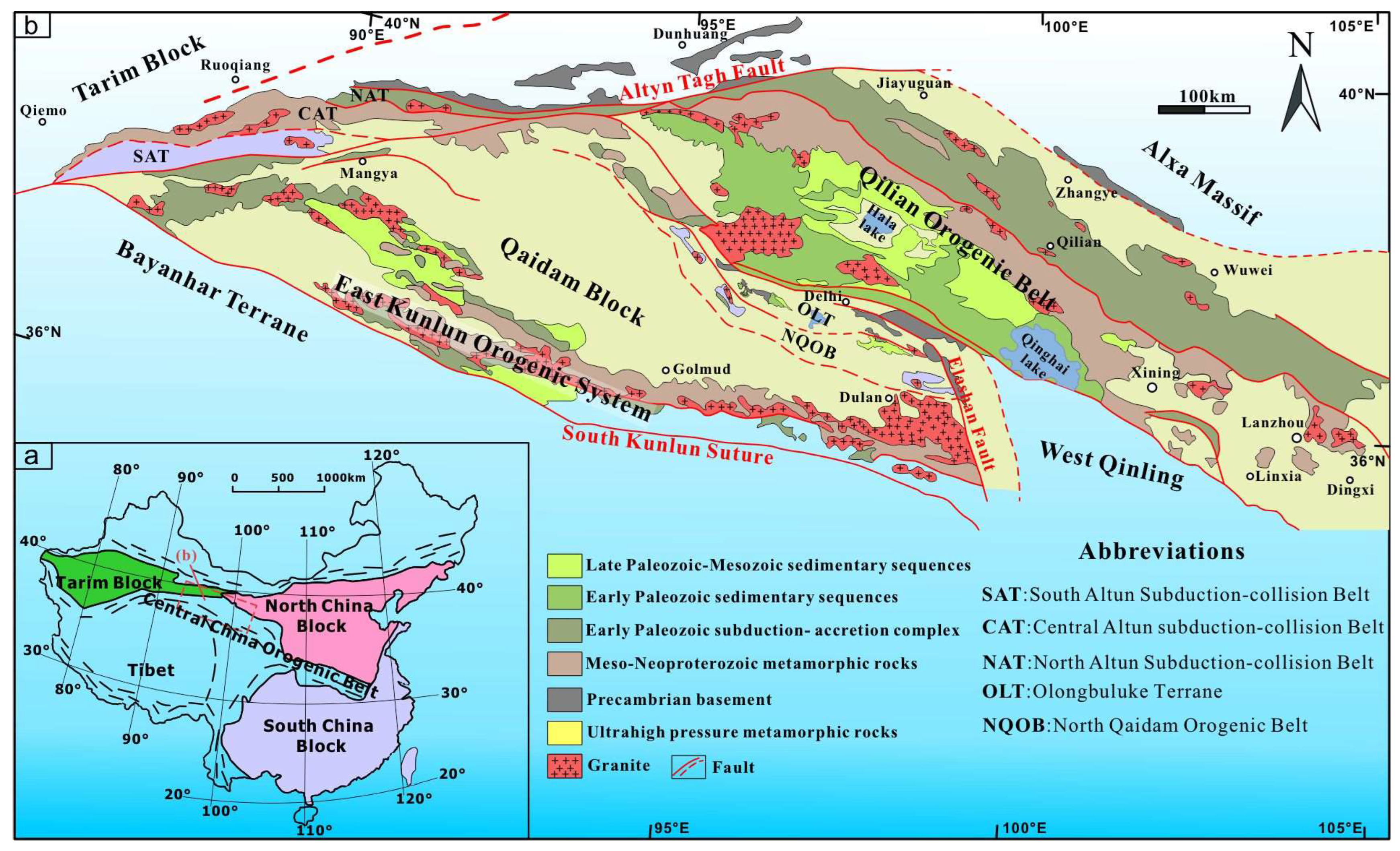
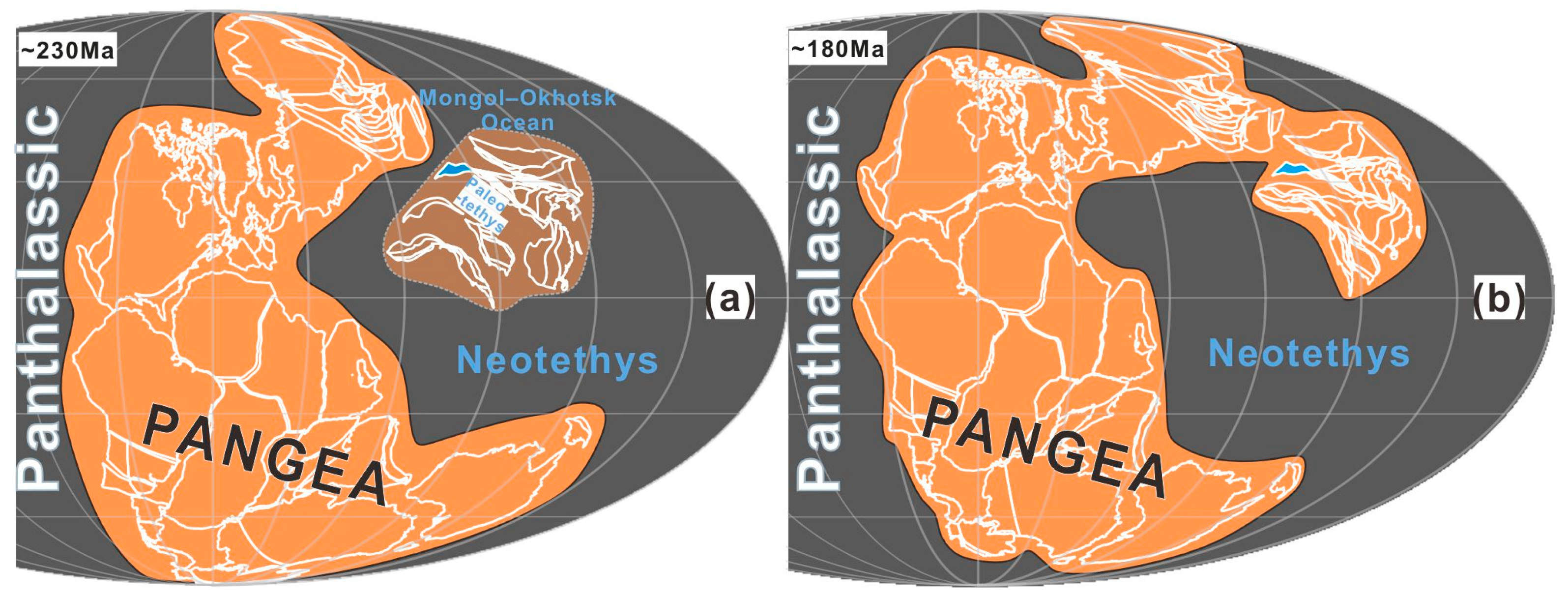
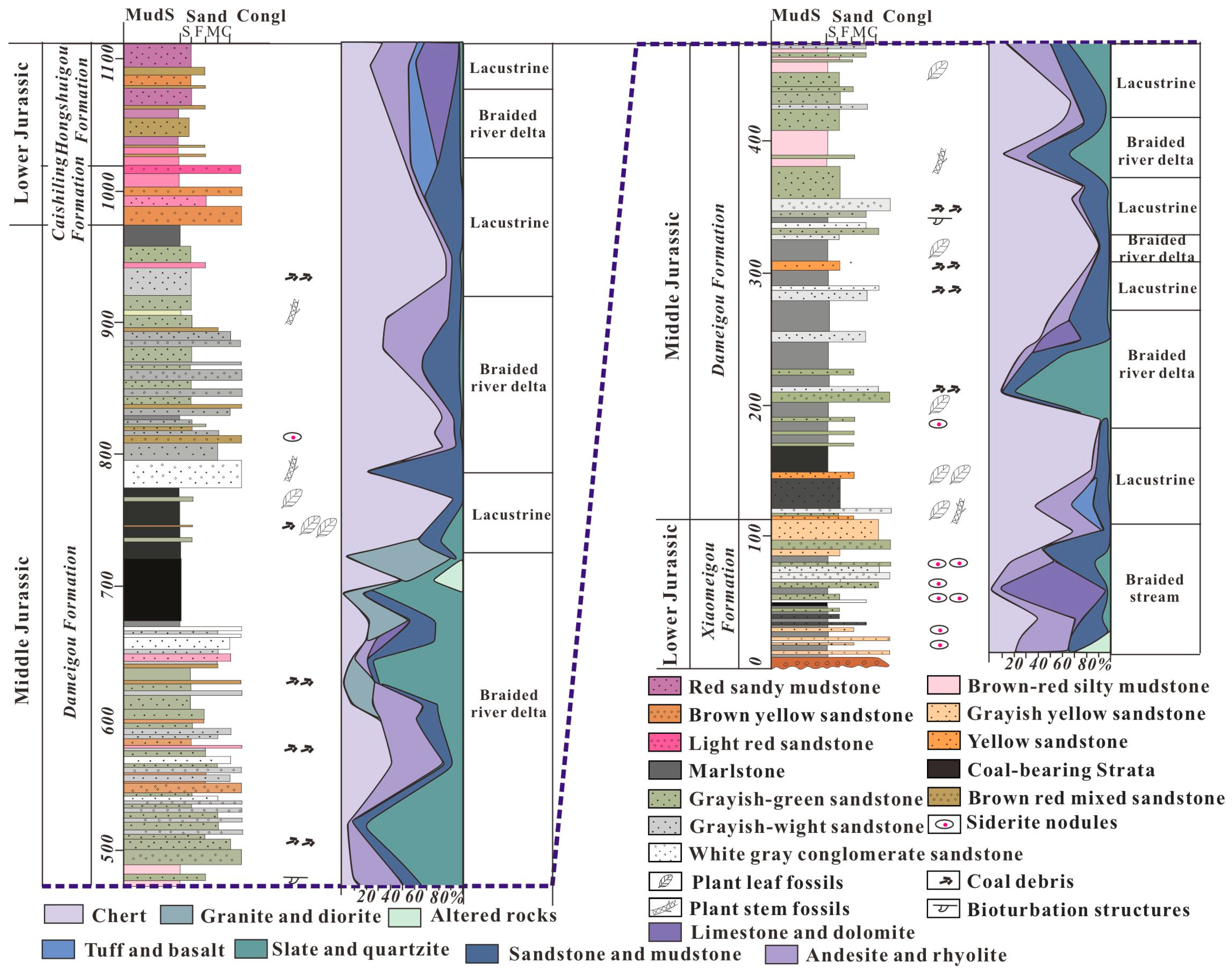
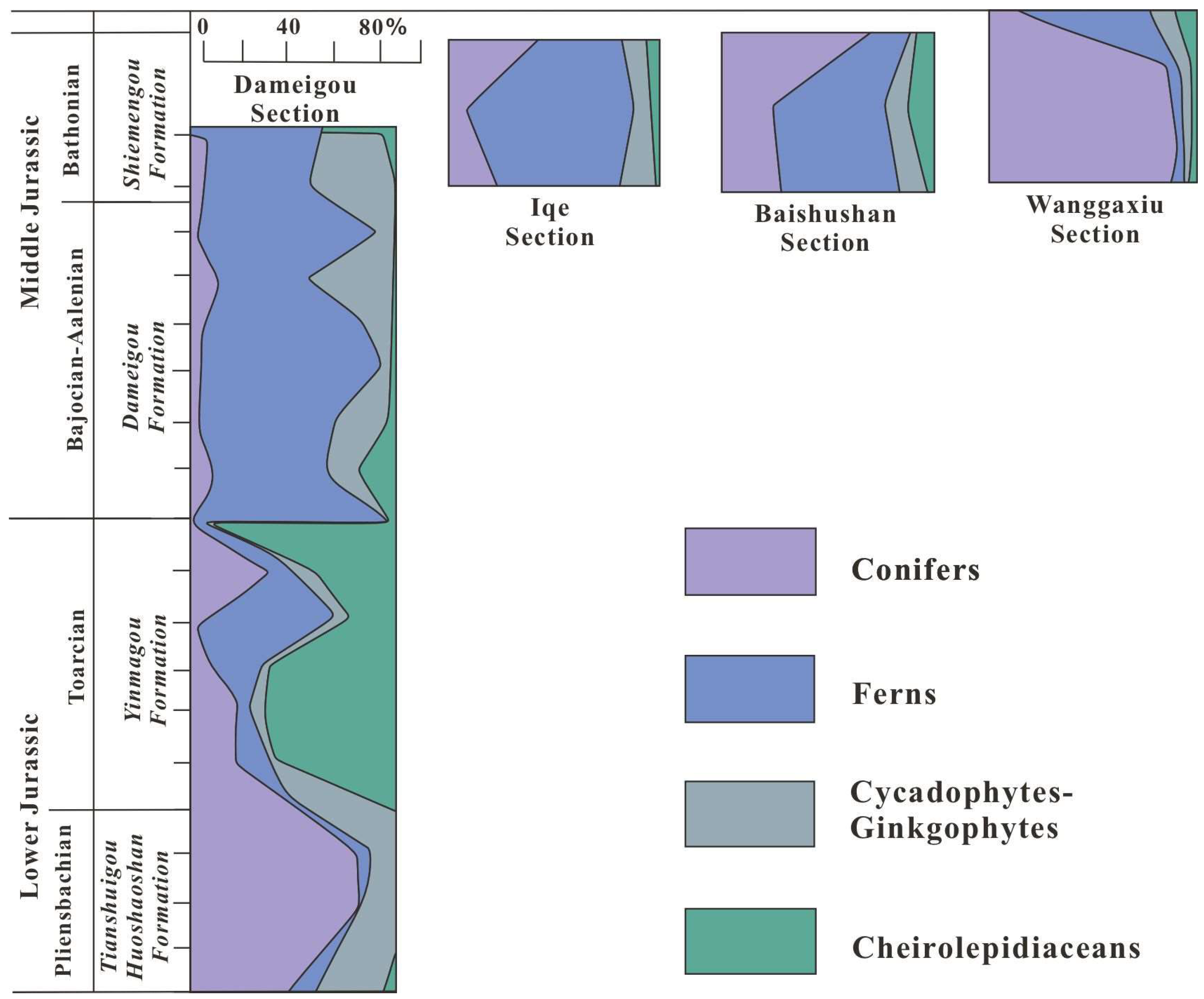
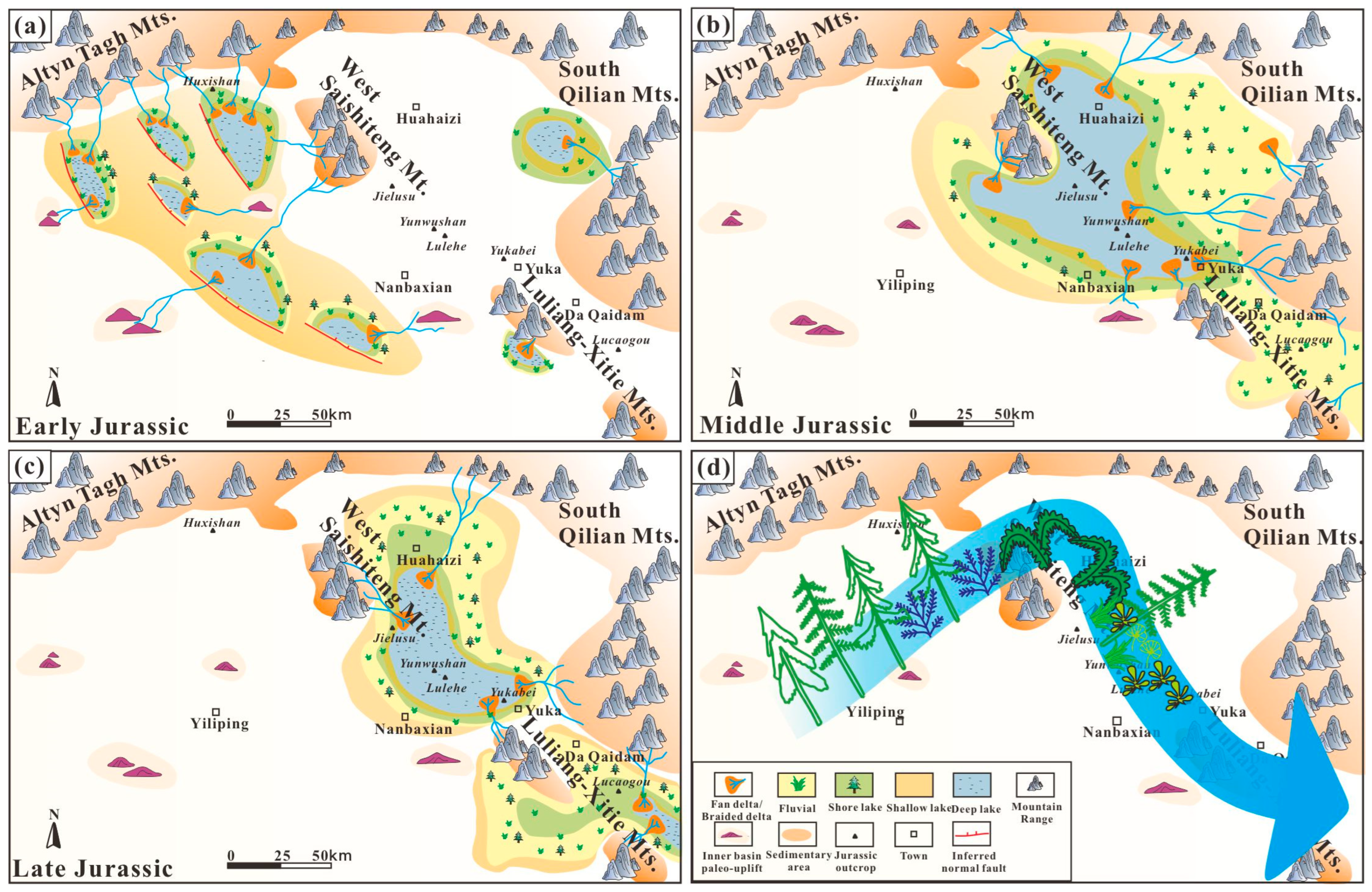
Disclaimer/Publisher’s Note: The statements, opinions and data contained in all publications are solely those of the individual author(s) and contributor(s) and not of MDPI and/or the editor(s). MDPI and/or the editor(s) disclaim responsibility for any injury to people or property resulting from any ideas, methods, instructions or products referred to in the content. |
© 2025 by the authors. Licensee MDPI, Basel, Switzerland. This article is an open access article distributed under the terms and conditions of the Creative Commons Attribution (CC BY) license (https://creativecommons.org/licenses/by/4.0/).
Share and Cite
Chai, R.; Zhou, Y.; Xiong, A.; Chen, Z.; Liu, D.; Jiang, N.; Cheng, X.; Zhang, J.; Wu, H. A Review of Jurassic Paleoclimatic Changes and Tectonic Evolution in the Qaidam Block, Northern Qinghai-Tibetan Plateau. Sustainability 2025, 17, 7337. https://doi.org/10.3390/su17167337
Chai R, Zhou Y, Xiong A, Chen Z, Liu D, Jiang N, Cheng X, Zhang J, Wu H. A Review of Jurassic Paleoclimatic Changes and Tectonic Evolution in the Qaidam Block, Northern Qinghai-Tibetan Plateau. Sustainability. 2025; 17(16):7337. https://doi.org/10.3390/su17167337
Chicago/Turabian StyleChai, Ruiyang, Yanan Zhou, Anliang Xiong, Zhenwei Chen, Dongwei Liu, Nan Jiang, Xin Cheng, Jingong Zhang, and Hanning Wu. 2025. "A Review of Jurassic Paleoclimatic Changes and Tectonic Evolution in the Qaidam Block, Northern Qinghai-Tibetan Plateau" Sustainability 17, no. 16: 7337. https://doi.org/10.3390/su17167337
APA StyleChai, R., Zhou, Y., Xiong, A., Chen, Z., Liu, D., Jiang, N., Cheng, X., Zhang, J., & Wu, H. (2025). A Review of Jurassic Paleoclimatic Changes and Tectonic Evolution in the Qaidam Block, Northern Qinghai-Tibetan Plateau. Sustainability, 17(16), 7337. https://doi.org/10.3390/su17167337






